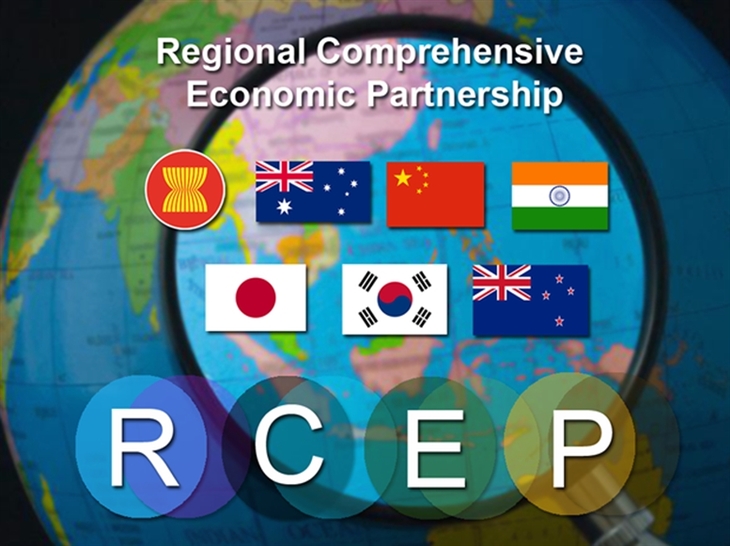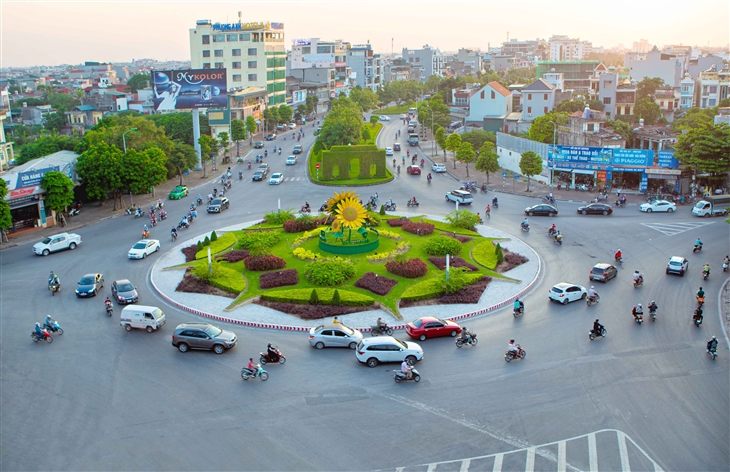RCEP and the human resource problem in key industries
Monday, September 29,2025
AsemconnectVietnam - RCEP Agreement opens up economic and employment opportunities but to take advantage, Vietnam needs to improve labor productivity and have a long-term strategy to develop competitive human resources.
Human resource barriers
Officially taking effect from January 2022, Regional Comprehensive Economic Partnership (RCEP) has become the world's largest free trade agreement (FTA) with participation of 15 countries, including 10 ASEAN countries along with China, Japan, Korea, Australia and New Zealand. A notable point of RCEP is commitment to eliminate about 90% of import taxes within 20 years, thereby promoting trade, investment and strengthening economic connectivity in the region.
According to research by Asian Development Bank (ADB), by 2030, RCEP could help increase income of member economies by 0.6%, equivalent to 245 billion USD per year, while creating 2.8 million new jobs. These figures show that RCEP brings clear benefits, opening up opportunities for economic development, employment and income for workers, including Vietnam. In fact, participating in RCEP is creating a great demand for human resources in many key areas, especially import and export, logistics, semiconductor industry, information technology, high technology... Along with that, with a series of bilateral and multilateral FTAs being implemented, Vietnam's import and export activities will develop strongly, leading to increasingly high requirements for labor quality. Businesses require a workforce with in-depth expertise in supply chain management, logistics and international trade as well as soft skills such as communication, foreign languages and ability to adapt to global corporate culture. This is foundation for Vietnam to take advantage of opportunities from FTAs, enhancing its competitiveness in the international market.
While bringing great opportunities to economy, RCEP also poses significant challenges for Vietnamese labor market. According to Dr. Nguyen Bich Lam, former Director General of General Statistics Office (now the General Statistics Office, Ministry of Finance), Vietnam's labor productivity in 2024 will increase by 5.88%, the highest level in many years and exceeding the set target. However, Vietnam's average productivity is only about 7,200 USD/worker, only 62% of Thailand, 41% of Malaysia and less than 1/10 of Singapore.
Notably, Vietnam's labor productivity growth rate is slowing down, from 6.2% in 2011-2015 period to 5.8% in 2016-2020 period and only about 4.8% in the 2021-2024 period. Labor productivity gap between Vietnam and many developed countries in region is still quite large, clearly shown in creativity, practical skills, foreign language proficiency and overall labor efficiency. "Although quality of domestic human resources has improved significantly in recent years, it still does not meet requirements of the deep integration process. When RCEP removes trade barriers, competition will not stop at goods or services but expand to the labor market," said Mr. Lam, adding that improving vocational skills, promoting foreign language training and applying technology will be key solutions to help Vietnamese workers take advantage of opportunities and be able to compete with high-quality human resources of other countries.
Solving the problem of high-quality human resources
With an impressive growth rate of 10-15% per year, logistics industry is currently considered one of the fields with strong development and important contributions to socio-economic development process. However, Vietnam is facing a big challenge: shortage of high-quality human resources in logistics sector. Currently, labor supply for logistics services only meets about 40% of actual market demand, which poses an urgent problem of improving quality and scale of training to meet growing needs of the industry.
Sharing at seminar "Training and developing logistics human resources towards sustainable development and integration" organized by Industry and Trade Newspaper, Dr. Vu Minh Tien, Vice Principal of the Ho Chi Minh City College of Foreign Economic Relations said that the school, with its strength of more than 10 years of training and supplying logistics human resources, is continuing to innovate its curriculum. Accordingly, subjects are integrated with modern supply chain management software, while supplementing knowledge and skills associated with digital transformation, green transformation and circular economy.
In parallel with theoretical training, school also strengthens connections with businesses, bringing students directly to warehouses, seaports, and transportation units to experience reality. This approach helps learners shorten the gap between training and the labor market, quickly adapt to new requirements, thereby better meeting demand for high-quality human resources in the strongly developing logistics sector.
Regarding high-tech industries, Associate Professor Dr. Phung Trung Nghia, Principal of the University of Information and Communications Technology (Thai Nguyen University) said that in 2024, school has deployed, adjusted and enrolled 24 training programs with about 3,000 targets. Majors all focus on the field of digital technology, have high applicability, in line with national digital transformation orientation and trend of 4.0 industrial revolution. Notably, for the first time, the school has included the semiconductor microchip training plan in the goal of providing high-quality human resources for high-tech enterprises, contributing to meeting rapidly increasing demand of the market. In addition to focusing on education and in-depth training in high-tech industries, Associate Professor Dr. Phung Trung Nghia emphasized need to closely link with leading enterprises in field of semiconductors and technology to form a strong human resource ecosystem. This helps students access practical experience, ensuring that human resource supply meets global standards.
At the same time, development of a national competency standard program for high-tech sector is an urgent requirement, helping training institutions clearly identify the criteria, skills and professional standards that learners need to achieve, thereby creating consistency, improving quality and competitiveness of Vietnamese human resources.
Source: Vitic/ congthuong.vn
Officially taking effect from January 2022, Regional Comprehensive Economic Partnership (RCEP) has become the world's largest free trade agreement (FTA) with participation of 15 countries, including 10 ASEAN countries along with China, Japan, Korea, Australia and New Zealand. A notable point of RCEP is commitment to eliminate about 90% of import taxes within 20 years, thereby promoting trade, investment and strengthening economic connectivity in the region.
According to research by Asian Development Bank (ADB), by 2030, RCEP could help increase income of member economies by 0.6%, equivalent to 245 billion USD per year, while creating 2.8 million new jobs. These figures show that RCEP brings clear benefits, opening up opportunities for economic development, employment and income for workers, including Vietnam. In fact, participating in RCEP is creating a great demand for human resources in many key areas, especially import and export, logistics, semiconductor industry, information technology, high technology... Along with that, with a series of bilateral and multilateral FTAs being implemented, Vietnam's import and export activities will develop strongly, leading to increasingly high requirements for labor quality. Businesses require a workforce with in-depth expertise in supply chain management, logistics and international trade as well as soft skills such as communication, foreign languages and ability to adapt to global corporate culture. This is foundation for Vietnam to take advantage of opportunities from FTAs, enhancing its competitiveness in the international market.
While bringing great opportunities to economy, RCEP also poses significant challenges for Vietnamese labor market. According to Dr. Nguyen Bich Lam, former Director General of General Statistics Office (now the General Statistics Office, Ministry of Finance), Vietnam's labor productivity in 2024 will increase by 5.88%, the highest level in many years and exceeding the set target. However, Vietnam's average productivity is only about 7,200 USD/worker, only 62% of Thailand, 41% of Malaysia and less than 1/10 of Singapore.
Notably, Vietnam's labor productivity growth rate is slowing down, from 6.2% in 2011-2015 period to 5.8% in 2016-2020 period and only about 4.8% in the 2021-2024 period. Labor productivity gap between Vietnam and many developed countries in region is still quite large, clearly shown in creativity, practical skills, foreign language proficiency and overall labor efficiency. "Although quality of domestic human resources has improved significantly in recent years, it still does not meet requirements of the deep integration process. When RCEP removes trade barriers, competition will not stop at goods or services but expand to the labor market," said Mr. Lam, adding that improving vocational skills, promoting foreign language training and applying technology will be key solutions to help Vietnamese workers take advantage of opportunities and be able to compete with high-quality human resources of other countries.
Solving the problem of high-quality human resources
With an impressive growth rate of 10-15% per year, logistics industry is currently considered one of the fields with strong development and important contributions to socio-economic development process. However, Vietnam is facing a big challenge: shortage of high-quality human resources in logistics sector. Currently, labor supply for logistics services only meets about 40% of actual market demand, which poses an urgent problem of improving quality and scale of training to meet growing needs of the industry.
Sharing at seminar "Training and developing logistics human resources towards sustainable development and integration" organized by Industry and Trade Newspaper, Dr. Vu Minh Tien, Vice Principal of the Ho Chi Minh City College of Foreign Economic Relations said that the school, with its strength of more than 10 years of training and supplying logistics human resources, is continuing to innovate its curriculum. Accordingly, subjects are integrated with modern supply chain management software, while supplementing knowledge and skills associated with digital transformation, green transformation and circular economy.
In parallel with theoretical training, school also strengthens connections with businesses, bringing students directly to warehouses, seaports, and transportation units to experience reality. This approach helps learners shorten the gap between training and the labor market, quickly adapt to new requirements, thereby better meeting demand for high-quality human resources in the strongly developing logistics sector.
Regarding high-tech industries, Associate Professor Dr. Phung Trung Nghia, Principal of the University of Information and Communications Technology (Thai Nguyen University) said that in 2024, school has deployed, adjusted and enrolled 24 training programs with about 3,000 targets. Majors all focus on the field of digital technology, have high applicability, in line with national digital transformation orientation and trend of 4.0 industrial revolution. Notably, for the first time, the school has included the semiconductor microchip training plan in the goal of providing high-quality human resources for high-tech enterprises, contributing to meeting rapidly increasing demand of the market. In addition to focusing on education and in-depth training in high-tech industries, Associate Professor Dr. Phung Trung Nghia emphasized need to closely link with leading enterprises in field of semiconductors and technology to form a strong human resource ecosystem. This helps students access practical experience, ensuring that human resource supply meets global standards.
At the same time, development of a national competency standard program for high-tech sector is an urgent requirement, helping training institutions clearly identify the criteria, skills and professional standards that learners need to achieve, thereby creating consistency, improving quality and competitiveness of Vietnamese human resources.
Source: Vitic/ congthuong.vn
Taking advantage of RCEP to exploit billion-dollar Halal market
Many industries will benefit from Vietnam - Israel FTA
Vietnam domestic steel market – September 2025
Vietnam domestic animal feed market – September 2025
Vietnam Fertilizer Market – September 2025
Assessing the impact of the EVFTA agreement on Vietnam's coffee exports to the EU in the first 5 months of 2025
Exports to Netherlands reached over 8.6 billion USD in 8 months of 2025
Wheat imports worth over 1.02 billion USD in 8 months of 2025
Vietnam to achieve target of 65 billion USD in agricultural, forestry and fishery exports
Vietnam - Singapore trade turnover reached nearly 26 billion SGD
Fruit and vegetable exports accelerate towards a record of 8 billion USD
Corn imports reached nearly 1.73 billion USD in 8 months of 2025
The multi-billion dollar industry seeks strategic direction in RCEP
RCEP creates a 'new wind' for Vietnam's pangasius exports

Plan of Hai Duong province for a period of 2021 - 2030, ...
Organize space reasonably and harmoniously, focusing on connecting Hai Duong in common development space, actively contributing to the ...Plan of Hau Giang province in a period of 2021 - 2030, ...
Sustainable forestry development program in a period of ...

LION Championship 25 to feature title showdowns in Khanh ...
LION Championship 25 will take place at Cam Ranh Square in south-central Khanh Hoa province, at 20:00 on August 16, featuring two of the ...Bai Dinh Pagoda named outstanding destination with ...
Party chief attends special political–art programme “Under ...



